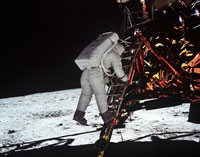Is new space race just around the corner?
The month of October was rife with developments directly related to space exploration.

Manned spaceflights to the International Space Station held the spotlight. News agencies provide continuous coverage of the operations at the ISS, which has been steadily building its new modules. The number of countries that aim to take part in a new space race is on the increase. Apart from Russia, China and the United States, South Korea and Israel recently announced their space programs.
Russia’s space agency Roskosmos is apparently making an effort to keep up with the rest of the club poised for near-earth space exploration. Russia looks set to intensify its cooperation with countries that are about to make the first step in space exploration. Russia committed itself to helping South Korea develop national space infrastructure. Besides, Russia will also help the country to build a launch vehicle. In commemoration of impending Russia-South Korea space cooperation, Roskosmos Head Anatoly Perminov recently paid a visit to South Korea, bringing a soil sample of the Baikonur Cosmodrome, which has been the main launch complex for Soviet, and now Russian spaceflights since the earliest days of space exploration. It is the same launch complex that was used for Yuri Gagarin’s first manned orbital flight in 1961. In line with its continuing space cooperation program for the deployment of foreign satellites into space, Roskosmos announced plans for the launch of an Israeli satellite Amos-3, slated for 2008. The satellites of Amos family are designed for rendering telecommunications services. Two Amos satellites are currently in orbit. There are plans for launching two more satellites of the same type. The Amos-3 is a third-generation satellite, weighing 2 tons. Its estimated cost is about $170 million. The Amos-3 will probably supersede the Amos-1, which is owned by an aviation industry corporation.
Aside from putting the Shuttle program back on track, NASA stepped up efforts to stage America’s comeback to the Moon. The National Aeronautics and Space Administration announced a special lunar exploration program. NASA is planning to design and build Ares-V, a heavy-lift launcher. Funds will be also allocated for the development of equipment to be used on the surface of the Moon. To combine all the efforts aimed at lunar exploration, NASA Lunar Science Exploration Institute is expected to get off to a running start as early as March 2008. Some analysts are confident that a new era of lunar race is dawning. Taking into account that Russia also announced its far-reaching ambition to go ahead with a lunar exploration program, the new lunar race may as well be waiting in the wings. However, Roskosmos is focusing efforts on Mars exploration, which is considered as having better prospects for research.
China’s space exploration plans looks as impressive as those revealed by the United States and Russia. On October 24, 2007, China successfully launched the “Chang’e-1” lunar orbiting spacecraft from Xichang Satellite Launch Center. Besides, the Chinese announced plans for the development of Chang Zheng 5, a new rocket of the Chang Zheng (Long March) family of expendable launch systems. According to data released by the China Academy of Launch Vehicle Technology, the new rocket will be capable of carrying 25 tons of payload for low earth orbit and 14 tons of payload for geostationary orbit. The Chang Zheng-2F can currently carry 9 tons of payload (LEO) and 5 tons of payload (GEO). Besides, China joined Russia’s Phobos-Grunt Martian exploration program. Chinese scientists are busy developing a microprobe that should put a Russian spacecraft onto the surface of the Red Planet. The Chinese are using expertise and experience gained during the development of the Chang’e-1 lunar orbiter. China is expected to actively continue the implementation of its manned space exploration program. The launch of a spacecraft with three taikonauts on board is scheduled for 2008.
In view of the above, it is safe to say that quite a few countries are allocating considerable resources for the exploration of both near space and outer space. Perhaps we now stand on the threshold of a new space era.
Nezavisimaya Gazeta
Translated by Guerman Grachev
Pravda.ru
Subscribe to Pravda.Ru Telegram channel, Facebook, RSS!





